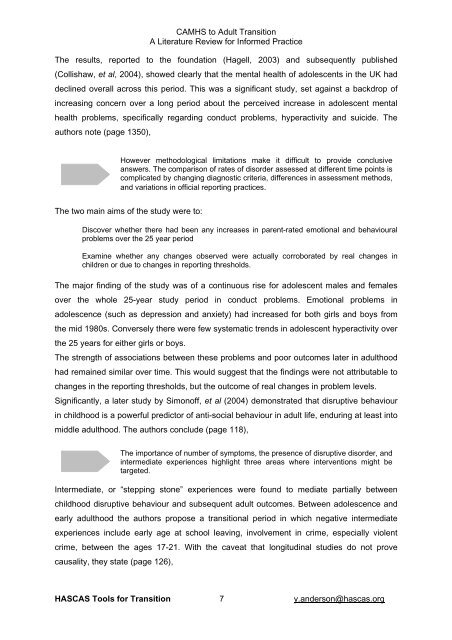Report - London Borough of Hillingdon
Report - London Borough of Hillingdon
Report - London Borough of Hillingdon
Create successful ePaper yourself
Turn your PDF publications into a flip-book with our unique Google optimized e-Paper software.
CAMHS to Adult Transition<br />
A Literature Review for Informed Practice<br />
The results, reported to the foundation (Hagell, 2003) and subsequently published<br />
(Collishaw, et al, 2004), showed clearly that the mental health <strong>of</strong> adolescents in the UK had<br />
declined overall across this period. This was a significant study, set against a backdrop <strong>of</strong><br />
increasing concern over a long period about the perceived increase in adolescent mental<br />
health problems, specifically regarding conduct problems, hyperactivity and suicide. The<br />
authors note (page 1350),<br />
However methodological limitations make it difficult to provide conclusive<br />
answers. The comparison <strong>of</strong> rates <strong>of</strong> disorder assessed at different time points is<br />
complicated by changing diagnostic criteria, differences in assessment methods,<br />
and variations in <strong>of</strong>ficial reporting practices.<br />
The two main aims <strong>of</strong> the study were to:<br />
Discover whether there had been any increases in parent-rated emotional and behavioural<br />
problems over the 25 year period<br />
Examine whether any changes observed were actually corroborated by real changes in<br />
children or due to changes in reporting thresholds.<br />
The major finding <strong>of</strong> the study was <strong>of</strong> a continuous rise for adolescent males and females<br />
over the whole 25-year study period in conduct problems. Emotional problems in<br />
adolescence (such as depression and anxiety) had increased for both girls and boys from<br />
the mid 1980s. Conversely there were few systematic trends in adolescent hyperactivity over<br />
the 25 years for either girls or boys.<br />
The strength <strong>of</strong> associations between these problems and poor outcomes later in adulthood<br />
had remained similar over time. This would suggest that the findings were not attributable to<br />
changes in the reporting thresholds, but the outcome <strong>of</strong> real changes in problem levels.<br />
Significantly, a later study by Simon<strong>of</strong>f, et al (2004) demonstrated that disruptive behaviour<br />
in childhood is a powerful predictor <strong>of</strong> anti-social behaviour in adult life, enduring at least into<br />
middle adulthood. The authors conclude (page 118),<br />
The importance <strong>of</strong> number <strong>of</strong> symptoms, the presence <strong>of</strong> disruptive disorder, and<br />
intermediate experiences highlight three areas where interventions might be<br />
targeted.<br />
Intermediate, or “stepping stone” experiences were found to mediate partially between<br />
childhood disruptive behaviour and subsequent adult outcomes. Between adolescence and<br />
early adulthood the authors propose a transitional period in which negative intermediate<br />
experiences include early age at school leaving, involvement in crime, especially violent<br />
crime, between the ages 17-21. With the caveat that longitudinal studies do not prove<br />
causality, they state (page 126),<br />
HASCAS Tools for Transition 7 y.anderson@hascas.org
















